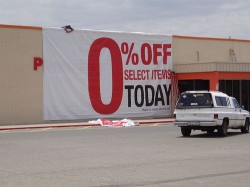
Image thanks to cosmickitty
There’s a lot of misunderstanding about “marketing offers.” When many people hear the word, they think it means a sale or a promotion of some kind, such as “two for one” or “30% off.”
Both are offers, but here’s the confusing part, an offer doesn’t have to be a sale. It’s just whatever you’re giving in return for something else.
A free book in return for an email address is an offer. So is a mens dress shirt for $30.
What’s an offer?
It’s a combination of:
- how many are included
- the price
- any personalization (like monogramming)
- payment terms (all at once, in installments)
- any bonuses (free cufflinks, or free monogramming)
- a guarantee
- a deadline to respond
- number available (if limited)
- shipping charges
- future obligations (the shirt-a-month club, or must buy three more shirts in six months)
(thanks to Dean Rieck for this comprehensive list)
Free starter kit
For instance, yesterday I passed a truck that had a web site address along the top, with an offer of a free starter kit. Further down, it said, “dry cleaning services.”
Without knowing anything more about the company, I can’t tell if this is a good offer or a bad one. And, who is the kit for? Are they trying to reach would-be owners of dry cleaning stores (with a starter package to set up shop)? Or consumers with dirty clothes?
What are the terms?
If they’re offering dry cleaning services to consumers, why do I need a starter kit? What’s in it? Why would I want one? Don’t I just bring in my clothes? Or, do they pick up and deliver, and offer a starter set of forms or labels of some kind? It didn’t say.
An offer is no good, particularly one on the side of a truck, if its terms are unclear, the audience is fuzzy, and the benefits are unknown.
What’s your offer? Have you tested it? Tried 20% off versus $10 discount? Is everything spelled out clearly? Go take look. I’ll wait. Come back later and let me know what you found.
Or, ask a question. I’ll answer it. Free. How’s that for an offer?




